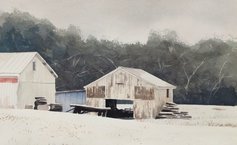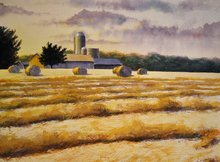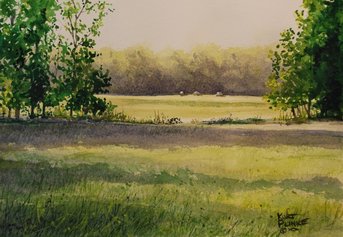| Kurt Plinke, Artist and Naturalist |
Between the Waters
life, Art and The Nature of things Between the Atlantic and the Chesapeake
|
We've lived along the Choptank River on Maryland's Eastern Shore for well over thirty years now. When we moved here, the land from the Bay Bridge to our place near Greensboro felt sadly empty and the drive seemed to take forever. Piloting our car along Route 50 and Route 404 was almost lonely, with a few bucolic farms and old homes nestled among long expanses of woods, marshes and neatly plowed fields. Unless it was a holiday weekend, even during beach season the road was never truly crowded. If you were one of those going home after a weekend at Ocean City, you probably stopped just before Kent Island at Holly's for a bite to eat. There weren't many other restaurants. The marshes near the bay were seas of grass, with a few old snags sticking up, perches for eagles, ospreys and dinosaur-like cormorants.  Today I taught a workshop at KIFA in Stevensville on Kent Island. It was a great day, with a group of painters who all did a great job as we developed a typical old Eastern Shore barn scene. But what struck me as I drove to Kent Island and back was the immense amount of change that has taken place all along the way. Just leaving our place, the road is now lined with houses where there used to be woods and fields. Farmland has been subdivided and homes are being built where old farmsteads used to stand. I'm not saying all of the farmland is gone... far from it. I still drove past a vast amount of farmland. But now some of those fields no longer grow crops, instead they farm the sun, covered as far as you can see with solar panels. That's not a bad thing, although I wonder why we have to cover some of the best farmland with something other than plants. As I travelled west, there seemed to be more and more change. Stores, restaurants and offices dot the former natural landscape. Much of the marsh is now filled with condominium complexes rising above the wetlands, and bordered by restaurants and shops.
Even the few places that were longstanding waypoints have changed. Holly's is long-gone, replaced by another Royal Farms convenience store. And while Royal Farms does make some good fried chicken, it's not a cultural stop for generations. It's just another Royal Farms, replacing homemade mashed potatoes with factory-processed potato logs. The drawbridge has been superseded at the narrows by a tall bridge, which overlooks a vast armada of sailboat masts all moored at huge marinas. The old drawbridge is still there, dormant in the shadows of the newer span. Restaurants and dockside bars crowd the narrows, and traffic on some weekends brings Route 50 to a standstill. For the last thirty years, the people I have come to know and love on the Shore have a certain rhythm to their lives. In the springtime, they fished for herring, rock and perch as they ran the rivers. Then they planted. In the summer, they tended their gardens and they crabbed, taking their sturdy workboats out on the bay and it's tributaries for rock, blues, and to run a line for bushels of crabs. In the early fall, Blinds were constructed in the marshes, and tree stands were tended so that later, duck, geese and deer could be collected and put up for winter. All this time, they kept a weather eye for storms. Today, however, there is a new rhythm. It doesn't completely take over the others, but it lays on them like a big wet blanket. It is known as Beach Traffic. Even now during off-season, a weather eye is blinded by traffic everyplace that there is a path to the ocean. Route 50 and Route 404 are virtual parking lots much of the time during peak season. It seems, too that the pace has increased dramatically. Everyone is in a hurry, ad they want everything now. It was nice to be able to stop at the Safeway on Kent Island and find an actual wide selection of groceries. On the other hand, the cashier was shouting, and everyone had someplace to go. Even in the parking lot, people were edgy and quick to temper. Many of the shoppers used the automatic check-out, avoiding the cashiers and the lines. The Safeway used to be a field, where fresh corn was collected, and the farmer was a quiet man. Things change. I'm pretty sure our children will say the same thing, lamenting the loss of a long-standing Royal Farms store, where they could find real fried chicken, and be served by a real cashier.
0 Comments
Plein Air Easton!... Actual Fruit... Using Green in a Painting... Upcoming Workshops.Before I start, I want to mention this weekend's watercolor workshop at the studio here near Greensboro. We'll be painting a Chesapeake workboat and it's reflection. Read more about it below, or here. 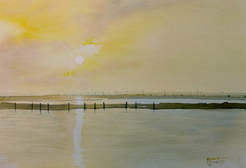 It is high summer here on Maryland's Eastern shore. The air is close and hot. In your ear there is always the not-so-subtle low hum of millions of mosquito wings in the close, wet air as the sun travels towards the horizon each evening. Here in Caroline County, a lingering odor of natural fertilizer, hanging in the heat is almost always at the edge of notice. While some of the things of summer are not the most pleasant, as July drips sweat on it's way to August, some of the best things in Maryland happen. These are the fruits of summer.  "Fern Shadow" This year's Quick Draw painting "Fern Shadow" This year's Quick Draw painting Plein Air Easton! One of the best of all of the fruits of summer is the nearby huge event that is Plein Air Easton! Last summer, I was insanely fortunate enough to be juried-in as one of the fifty-some artists participating in the event, spanning more than a week. The level of painting that takes place during this brief span is awesome. Artists like Tim Kelly, Patrick Lee, Trey Finney, Sarah Linda Poly and so many others boggle the mind at their ability to creatively interpret what they see. The paintings produced during this competition/festival are some of the most beautiful you will ever see anywhere. And to know that they are painted outdoors in brutal Eastern-Shore-in-July conditions where the humidity is over 90% and the temperatures exceed 100 degrees most days is the truly amazing part. Watching a plein air painter feverishly working to capture an azure shadow on a canvas while standing on a hot tar road (or roof, in Patrick Lee and Bradley Milligan's case), is amazing. This year, while not a juried artist, I participated during the week as an artist thankfully selected to display in the Local Color show taking place in the gallery at Downtown Easton's beautiful Tidewater Inn. Also during the week, I joined the juried artists and many others in the annual Quick Draw challenge, where the artists completed a painting, on location, in less than two hours. This year I think I completed my best Quick Draw painting, a fern hanging in front of a store near The Tidewater.  blackberries, nestled among thorns blackberries, nestled among thorns Actual fruit... Some of my favorite fruits actually grow wild behind and around the studio here outside of Greensboro. Blackberries, big and plump and sweet are ready for picking right now along the brambly tangled hedgerow at the edge of the woods. They are a summer delight in one way, and a bane in another. While they are delicious, the blackberry canes are studded with long, recurved spines, like fish hooks waiting to catch you as you reach for a dark shining berry in the shadows of the brambles. I bet I've picked three quarts of the beautiful little morsels this year, at the same time looking like I got into a drunken brawl with a sackful of angry badgers. My arms are covered in cuts and little puncture wounds from the dangerous spines.  passionflower passionflower Another fruit that I have come to love, and that grows wild in the same place as the blackberries, is the Purple Passionflower. Growing on a sprawling vine with beautiful tropical-looking flowers, the fruit develop as summer progresses. Before they are ripe, the tennis ball sized fruits are solid and green, and smell terrible. But when they are ripe, the fruit wrinkles a little, and is filled with small sacs of juice. The juice is amazing, and is one of the primary flavors in the drink, Hawaiian Punch.  passionfruit passionfruit I gather grocery bags full of the ripe fruit each year, extract the juice, and freeze it as ice cubes. The cubes, two to a glass with a little vodka, makes a great passion fruit martini. I suppose there are other ways to use the delicious liquid, but I don't see a reason to try anything else. It's that good. Using green in a painting... Now that summer is fully here, I'm faced with a dilemma. Everywhere I look, bright greens are everywhere. And that is great. Summer should be filled with green things growing, like the blackberry canes and passionflower vines. But for some reason, I prefer the subdued shades of autumn. Even when I'm painting a forest scene, I find I'm adding violet or burnt sienna to my greens, toning them down a little from their natural brightness. I had a discussion about this the other day with fellow artist Jim Rehak, who loves painting bold colors. We agreed that I naturally paint more along the lines of Wyeth, with a limited palette of subdued colors. I'm okay with that, but I want to work towards expanding my palette, and broadening my own preferences. 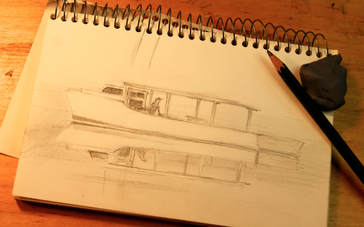 This Weekend's Workshop... If you haven't already signed up for this Saturday's watercolor workshop, "Painting a Chesapeake Workboat and it's Reflection," you'd better hurry. There are a few seats left. This should be a good day. We'll start with a bring-a-dish potluck lunch at 11:00. After we eat and talk, we'll head to the studio. There, beginners and more seasoned watercolorists will look at how to create realistic reflections, how to thoughtfully reserve whites in a painting where no paint is used, and how to make water look like... well... water. Not always easy, but the way we'll do it on Saturday will be straightforward and simple. Paper will be provided, and if you are a rank beginner, you can borrow a palette and brushes for the day. Sign up soon by calling (410) 200-1743 or emailing [email protected]. See you Saturday! A Workshop Full of Fun, What's Going on Out There, Painting as Fast as I Can, Shows Around the Shore, & this Month's Featured Painting (with a special low price)First, July's watercolor workshop at the studio... On Saturday, July 29th, we'll be painting a Chesapeake Bay workboat as it is reflected in calm water. An easy painting with some interesting techniques, including masking out whites and an effective way to accurately depict reflections in water. This is a great project for both novice and experienced watercolorists. To reserve a chair and be a part of this one-day workshop experience, contact the studio at [email protected]. For more information about this and other workshops, see here.  What's Going on Out There... Last month, I watched the Pink Lady's Slippers progress through their blooming cycle, beginning as a couple of small, unfurling wide green leaves. Then, a flower stalk began to poke it's way up from the center of the whorl of leaves. As the big bud at the top of the stalk opened, the bright pink flower began to nod, looking like some sort of weird shoe dangling at the end of the flower stalk. The Lady's Slippers were one of many species of flowers to be found in the woods in late May and early June. The trees had not fully leafed out, and plenty of sunshine managed to reach the forest floor. Now, however it is early July. The sun is shining brightly and longer. Even so, the woods are a dappled place of deep shadows, and the woodland flowers are few and far between. Now, the flowering plants are more prevalent in open spaces, along road edges, in marshes and in fields. Chicory, Queen Anne's Lace (really a wild carrot) and some early Asters dot open areas with bright splashes of blue and white. As lightning bugs begin to fill the sky with bright flashes, they are echoed in the marshes with the occasional big bright flower of the Marsh Mallow. Escaped Daylilies, free from their original garden homes, drift in orange-yellow clumps along the roadside. Down near the river, the scorching red of Cardinal Flowers surprise the eye with their brilliance. Summer has arrived. Painting as Fast as I Can... With Summer and warmer weather here, I've felt the urge to really get out there and paint what I see. This season, my goal is to paint faster, and to work to create more dynamic compositions as I paint both in the studio and en plein air. Oddly, while I have been working to paint faster, I found that for some time my painting has been in a rut, and I produced no paintings that I wanted to show anyone. The saving grace is that there is always the other side of the paper to try again. But now, I'm beginning to feel that I can see a light, and I'm heading towards it. I'm using different brushes, more contrast and really looking at the stories behind what I paint. I'm trying to get out of my "horizontal versus vertical" compositions and I hope that by the time Summer really heats up, I'll have some new work that I really like. Shows Around the Shore... I'll be a part of several plein air festivals and galleries over this Summer. - I'll be a part of the Plein Air Easton! festival as part of the Working Artist's Forum in their Local Color show, located in Easton, Maryland's Tidewater Inn on July 21st, 22nd and 23rd. - The Riverwalk Arts Center in Milford, Delaware will include several of my paintings as part of a two-month gallery exhibit entitled "Play." The arts center is open most days. - The Foundry in Denton, Maryland features a number of my paintings as part of their gallery rotation. I just added a number of new paintings to the gallery there. - Artists paint OC, a Plein Air event in Ocean City, Maryland starts on August 9th and runs through the 13th. During the event, I'll be traveling around the Ocean City area, painting en plein air. A closing exhibition of the paintings completed during the competition begins at The Center for the Arts in Ocean City, running through the remainder of August.  - One of the best events in Denton, Maryland each year is Summerfest, August 18th and 19th. As I do every year, I'll have a booth at the festival. This year, my son, Lloyd Plinke, will share the booth, displaying his sculpture and blown glass. His work is beautiful, interesting and very affordable.
I'm pretty sure that any artist has a favorite place to paint. Maybe two. Or three. I know I actually have four. But one seems, by default, to be my favorite place to paint.  My wife and I both agree that Chincoteague Island is probably our favorite place, and while we don't go there as often as we would like, it is almost always at the top of our list when we have a few days free. And while there, I have managed to get in a little painting, and have at least started a lot of paintings there. The problem I seem to have with Chincoteague is that there are so many simple things to do there, that I spend a lot of time not painting. So while Chincoteague may be my (our) favorite place, it probably isn't my favorite place to paint. 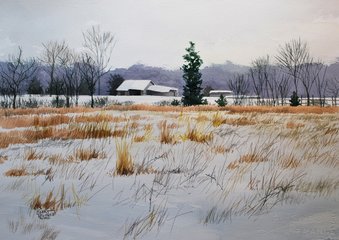 Another place I think may be a favorite place is a friend's farm, up near Henderson. I have been there many times, and have spent weeks in the snow, removing firewood from their logged-over field edges. Larry and Barb's farm, with it's cows, barns and fields is just about the most picturesque place to paint anywhere, as far as I am concerned. I could spend the rest of my life painting on their farm. Oddly, though, I have pretty much never finished a painting there. I've completed some sketches, a quick study, and lots of photographs, but no real plein air, paint-all-day kind of sessions. I love their place, and I love painting their place, but as far as spending time there painting, it just seems that I always have someplace else to be when I want to paint Barb's barns. The place where I actually truly do most of my painting is my studio, a repurposed room in our old pre-revolutionary home on the Choptank River. I try to paint there every day, and usually, I manage to get at least three or four hours in. (I'm averaging, here. There are days in a row when I don't paint, for a variety of reasons.) Overall, this is the place where I almost always go to paint. In the winter, in the summer, this is where my palettes stay full of moist paint, and where the lighting is always just right. Music to listen to, dogs to pet, and a nearby refrigerator all keep me just distracted enough to stay interested. Truly, the studio is the best place to paint. Except, I have another location where, through timing and circumstance, I seem to keep going back to.  I teach art at North Caroline High School. Firstly, I have to say that I have the perfect job. Caroline County Public Schools are the best. Anybody tells you different, they need to rethink their position. The county values education, and the school board has their head screwed on straight. The administration almost always seems to consider teacher's needs as they balance students, parents and others as they organize an exceptional educational system in a low-income rural county. My school's administration is responsive to student's needs, as best they can, given state regulations. My supervisor (Susan) is top-notch. So the school system is awesome here, as far as I see it. But beyond that, being a high school art teacher is an amazing way to spend a day. I get to listen to fascinating young people plan their lives, develop understandings of art and history, as I manage to keep myself a lot younger than I truly am, chronologically, just because I'm surrounded by young people. On top of that, I get to teach the best subject ever. I get to be a part of developing young artists minds. Awesome. I honestly can't wait to get to work every day. In fact, I almost always get to work at least forty five minutes early. Usually, I spend that time planning the day, grading papers, cleaning brushes or making a dent in my disorganized room. Sometimes though, (actually fairly often) I come into the room and look out my broad expanse of windows at some of the most beautiful rural scenery you can imagine. And some of those times, when my grading is caught up, and my disorganization is at an acceptable level, I spend some time before school painting what I see out of those broad windows. I paint the old dairy farm across the field. I paint it in the spring, in the winter and in the fall. I paint the river, peeking through the trees across the road from the school. paint the fields, especially on mornings when there is a spectacular sunrise, or when the newly-plowed furrows are blanketed with fog. In fact, as I look back over the past few years, I realize that I have painted a lot of pieces of paper, very early in the morning, based upon what I see out the windows of my classroom. Usually, these paintings are quick, merely sketches. I don't have time to complete a detailed, involved full-fledged painting. So most of these little studies will never be framed or showed to others. But I have really enjoyed my time, brush in hand, as I sit in a plastic school chair, with my brushes and travel palette, looking through the big eastward-facing windows of my classroom as I record what I see. That's my favorite place to paint.
Because of the warmer weather and the return of the small woodland birds, my thoughts have gone back to painting wildlife, especially the little jewel-like birds just returning from the south. Warblers often have brilliant flashing glimmers of golden yellow, and are fun to bring to life on paper. In fact, warblers are so much fun to draw and paint that I've made it the next workshop here at the studio. This workshop will be a little different. While we'll still share lunch, the first thing we will do is take a little walk. Actually, it will be more of a stroll, as we walk down the old dirt road by the studio, looking for warblers and plants to use as subject matter. Sketching as we walk, we'll decide together the kind of warbler we will paint. I can't wait to see what the group settles on... will it be a subtly colored Ovenbird, a pretty Pine Warbler, or something even brighter, like a Blackburnian Warbler? I guess we'll find out together. To sign up for the May 20th watercolor workshop, call the studio at (410) 200-1743 or email to reserve a chair at [email protected].
I especially love the challenge of trying new things as I paint. For so many years I spent my time in the studio painting things that I knew so well... a cardinal, a bluebird or some other animal. As I continue to paint, I want more and more to try new things and develop new ways to portray the world that I see. I think that this is why plein air has such an appeal, especially in warm weather. The chance to stand somewhere, look around, and create the feeling of the effects of light, shadow and texture in what I see appeals to me. Doing this as God's sun shines down on me just makes it better. Waxing... wax and watercolors just don't mix, right? I mean, putting wax on paper just creates a resist, a place on the surface where paint always refuses to adhere. Watercolorists are extremely cautious about waxes, oils and the like. Even having a tiny bit of wax or oil on your fingers and touching a piece of white paper ruins it for painting. So why talk about wax with watercolors? I'm experimenting right now to see if I can answer that question. A while back, I began to wonder if there was a way to paint with watercolors, but not frame the finished work under glass and surrounded by mats. Watercolors have been presented this way for close to a thousand years... glass to shield the watercolor from moisture in the air, and mats to protect the painting from moisture condensing on the inside surface of the glass. Artists using acrylic, oil and encaustic mediums don't worry so much about these problems. And I've envied them, but love water-based mediums so much that I don't want to change right now. The only time I came close was when I was painting a lot with egg tempera. With that medium, there is no need to protect the finished work, except to polish it. It seems strange, but pigment, water and egg yolk make a very durable medium. I began painting with egg tempera on a surface called Claybord, made by Ampersand.  Claybord is a piece of masonite, coated with a baked surface of hard white clay. Eventually, I tried using watercolors on the same surface. A little difficult at first, I grew to like using Claybord with watercolors. The paints lift very easily, meaning that pigment can be removed completely with a simple brush stroke. When the painting was finished, I used varnish to seal the surface. This worked, but only on days with low humidity (not a regular thing on the Eastern Shore). Then, the other day, I found an artist who mounted this finished watercolors (on paper), to a rigid surface. When the paper was secure to the surface, He used oil painter's wax to seal and protect the surface. When finished, the wax is polished and hardens, creating a durable protective layer. I tried it, and found that I like the results. Finally, watercolors that don't need glass. Right now I've only tried this process a couple of times. But I like the end product. The wax adds a warm glow to the painting, much like an oil painting that was glazed with a series of thin layers of almost transparent paint, and then varnished. The colors are richer and deeper. But best of all, the paintings are not surrounded by mats and glass. I know I'll be trying this some more. March's Watercolor Workshop, New Paintings, Workshop Schedule for the Year, and a Special OfferMarch's watercolor workshop at the studio will be "Perch Painting." Not a style of sitting, but a subject... we'll paint a local fish, the perch. (It will be the catch of the day, so the painting may be a yellow perch or a white perch.) On March 25th, we'll get together in the studio to enjoy a meal before we all get down to the business of painting a fish. This will be a classic watercolor study, with a wet-in-wet tinted background and attention to detail. Even so, we'll look at quick ways to add the impression of detail, with less work. That being the case, we will paint with a sleeve full of tricks that any watercolorist, new or old, will be able to use in many different painting situations. New Paintings As the old year passed into the past, I did something I have not done in quite a few years. I made a New Year's Resolution. When I was in grade school, we made resolutions each year, and I soon learned that the only thing that I ever did with a New Year's resolution was break it. Quickly. This resolution, however, has something different... a second resolution in which I resolve to keep the first resolution. Bam. Problem solved. And in fact, so far I have kept my new resolution... clear into the beginning of March. I resolved to complete at least four new paintings each week. (I also resolved to spend at least four hours each day in the studio. Admittedly, I have had to modify that one, making it something more like, "...an average of four hours per day," and I had to include "...or in the frame shop," in order to keep that streak going.) The thing that I have really been happy about with this more rigorous painting schedule has been the quality of many of the paintings that I have completed. It seems as though the more I push myself to finish paintings, the more I like what I am painting. I think it is because I am spending less time "fussing" with tiny details, and am more rapidly blocking in shapes, colors and values. When I start to slow down, I don't like the results anywhere nearly as much. As I finish these new paintings, I have been posting the ones that are not too fussy on Twitter, Facebook, and to a lesser extent, Instagram and Tumblr. And as a result, I have seen many of these new arrivals find new homes. The paintings are coming and going. Workshops for the remainder of 2017 have been scheduled into Sewell Mills Studio. Plan on participating in them all!
SPECIAL OFFER: sign up and pay for two workshops at least two weeks in advance, get $10 off! Offer valid through May, for any of the workshops scheduled. Mention this offer when signing up for the workshops. See here for more information. ABOUT THE COMING OF WINTER, PAINTING IN A CHILL WIND, THIS MONTH'S PAINTING OF THE MONTH, AND UPCOMING EVENTS AT SEWELL MILLS STUDIO & GALLERY First of all, be sure to check the Shows and Workshops page for a new January watercolor workshop scheduled at the studio for January 28th. We'll be painting an early winter watercolor landscape. Should lots of fun, so sign up early. 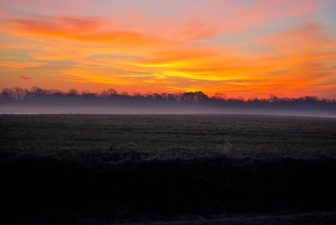 December is here, as of this morning, on the Eastern Shore. Yesterday it rained all day and was almost seventy degrees. Fog hung near the ground all morning, and it felt more like early Spring than the closing of days of Fall. And earlier in the week, before the rain started, the sunrise... you should have seen the sunrise. Gorgeous oranges, pinks, and violets. Even then, ground fog from the warm field soil lay at woods edges, a glimmering dividing line between earth and air. But this morning was different. No wisps of fog, no brilliantly colored sky, no clouds or rain. The cold in the morning air made my lungs hurt, and the still-moist soil from yesterday's warm rains has turned to a chilly dampness that just says to anyone listening that Winter is coming, and coming soon. The nearly cloudless sky echoed the message, looking like a horizon-to-horizon overhead ice rink. John Snow would start fingering the pommel of Longclaw if he were to look upon the scene. I'd almost be willing to bet we have snow by Christmas. I wouldn't mind an early snow. Winter watercolors are fun to paint, and often result in some of my favorite paintings. That said, I don't like painting outside during really cold weather. My paints freeze, my fingers freeeze and my glasses frost up. Standing in snow for three or four hours as a painting takes shape winds up with some pretty cold feet. A lot of mid-Winter plein air paintings wind up being completed looking out of my car window, just to keep paints above the freezing point and toes from frostbite danger. So for now with colder weather only beginning to set in, paints are only cold, fingers can still wiggle, and I can still see through my glasses. Pretty sure you'll find me working on some sunrise paintings this weekend, with only marginally cold feet, and fairly cold paint. 
I'm starting a new feature on my website and in the gallery. Each month I'm offering up a single original watercolor at a special reduced price, as a first-come, first-served "Painting of the Month." This month, the painting that needs a home is one of my favorites, "AFTER THANKSGIVING," painted in burnt colors of pumpkin, tints of pale melting snow and earthy browns. Just click on the painting to the left for details on how to claim this painting before anyone else gets it first.
Beyond snow and cold, beyond a good deal on a favorite painting, there is a January watercolor workshop at the studio. This one should be especially good. Everyone will paint a different early Winter landscape involoving bare trees and a field edge and barns. Contrast, perspective and pattern will be the forward elements and concepts as we develop a well-composed landscape with a feeling of coming snow. It should be fun, better sign up early.  They laugh at us from the clouds ...and from the fields, and from the parking lots and the Boardwalk. It's as though the heavens constantly mock and tease us, practically wherever we are on the Eastern Shore. This is a blog on one level that is about wildlife on the Shore. On another level, it highlights the subject of June's workshop in the studio. But it goes deeper than that, beyond some words describing a species of bird called the Laughing Gull. These birds and their echoing calls are so much a part of what life on the Eastern Shore is about that it would be hard to imagine what this place would be like without them. Their call sort of seeps into everyone here, a constant reminder that while many are farmers or spend every day in a building and not on a boat, we are never far from water... just to the East the Atlantic, just to the West the Chesapeake. I remember moving to the Shore from Ohio a few decades ago, and being in a state of constant amazement at the clouds of bright gray and white noisy birds with the black heads, dancing high overhead. They always seemed to be there. Other times, as a disk or plow turned the ground in some field, I watched as gulls followed the tractor like billowing fluffs of dust, all the while drowning out the motor with constant stuttering laughter. Coming from Ohio, where we called them all "Seagulls," (as opposed to "Gulls") seeing clouds of Laughing Gulls out in a farm field was a cultural and locational shock. Even at the big box stores or fast food places in Denton, Easton or Dover, walking from your car to the door can sometimes seem like an obstacle course as gulls loiter nearby or run around near your feet, hoping that something edible is dropped. They hang around in little gangs, like street toughs, looking to accost anyone who looks sideways at them.  Of course, Ocean City and the surrounding beaches are filled with Laughing Gulls all Summer long. If you are brave enough to buy some Thrasher's french fries up on the boardwalk, you are surrounded by them, laughingly demanding that you toss a fry into the air. Seeing their insistent begging, every child has to try to feed a gull. Only once, though. They innocently and happily throw a piece of hotdog bun or a fry upwards, and then the mayhem begins. first two, then four, then hundreds of gulls flap in a mass around the child, each one loudly demanding to be fed. The scene is straight out of a Hitchcock movie. Eventually, the cloud of gulls melts away, two or three at a time to go back to their regular stations in the sand, while the now-wiser child stands on the boardwalk, just a teensy bit fearful of the ubiquitous black-headed beach birds. What would really frighten a child, however, would be a stroll through a Laughing Gull rookery. These birds, along with Ring-billed Gulls, Herring Gulls, Skimmers, Terns and a few other communally-nesting species gather on isolated small sand spits in the Chesapeake Bay and in the back bay between Atlantic barrier islands and the mainland. On these islands thousands of birds nest, packed together beak-to-tail. Their constant flitting and flapping and their deafening calls make the island seem almost like a living being, settled low to the water. Once eggs have hatched, the young birds cover the sand as parents ferry small fish, crabs and scraps from the beaches to their hungry youngsters. Soon the new gulls are able to fly, and head to the beaches, fields and parking lots, looking for food on their own. In the Fall, Laughing Gulls lose their high-contrast headgear as they molt their Summer feathers for more drab winter dress. The once-dapper flocks then leave the Eastern Shore for warmer weather. Some settle in Florida, while others go farther, sometimes all the way to northern Central America. It's strange to suddenly no have laughter echoing from the sky. They leave at about the same time other calls begin. Canada Geese, Snow Geese, and Tundra Swans all have distinctive calls, each dong their part to fill the void left by the absence of the Laughing Gull. For me, the honking of geese just can't replace the raucous laughter that drifts from the clouds of Summer. Farmers in the fields notice the absence, the large blacktopped lots seem just a little barren, and the beach is a lonelier place without them. Laughing Gulls are one of the things that Make the Eastern Shore it's own place. Their echoing laughter and cackling from high overhead tell us where we are... and in a sense, who we are. Without them, we might as well be in Ohio, or Kansas, or Oklahoma, where the tractors just raise clouds of dust, and children who drop a bit of sandwich in a parking lot don't feel the amazement as a flock of black, gray and white creatures swoop down to boisterously bicker over the sudden treat. "Painting a Summer Gull" This month, if you participate in the watercolor workshop at Sewell Mills Studio on June 28th, you'll get a good idea of how to paint a Laughing Gull, taking home a representation of an icon of the Eastern Shore heritage and way of life. During the workshop, we'll all paint a Summer Laughing Gull, perched on a post. The clean white and gray feathering will present an interesting challenge; how to add subtle texture to the virtually smooth birds. The challenge is not insurmountable. In fact, people new to watercolors will quickly see that a bit of layering will give their paintings a feeling of volume and form, all the while giving their gull just the right amount of "feather feel." I hope to see you there. Summer Plein Air: Over June and July, I'll be taking part in several plein air painting competitions. I plan to post daily blogs during these events; what I've painted and what I've seen. It should be an interesting Summer.
The Ospreys are back. Let's paint them. (News about my Summer painting plans, too.)This entry is about several things, including:
But first, a bit about Ospreys: I recently wrote an entry about one of my favorite birds of prey, the Red-Shouldered Hawk. I like this bird for lots of reasons, including their call, the way they have they courtship flights over the house in the springtime, and their beautiful coloration. Red-Shouldered Hawks are amazing birds.  They really are amazing, as well as interesting and another of my favorite birds. However, they appeal to me in different ways than the Red-Shouldered. Ospreys do not have majestic, screaming calls. They sort-of twitter and tweet. They do it loudly, but still... Ospreys, like Red-Shoulders, do have an amazing mating flight, during which they soar and dive repeatedly while calling. When the male Osprey dives, it is something to see. Ospreys are not brightly colored birds. Mainly dark brown and white, they do not have the gorgeous colors of a Red-Shoulder or a Red-Tailed Hawk. Even so, they sport a sort of dapper elegance in their clean colors. Ospreys, more than anything, are amazing hunters. Feeding almost entirely on fish, Ospreys hunt from the wing. While Red-Shoulders tend to sit passively while hunting, Ospreys soar overhead, scanning the water for for fish near the surface. If they see a fish, they often will hover in one spot over the fish, a neat trick for a bird as big as an Osprey. Suddenly, they plummet towards the water, feet and talons first as they hit the water, sometimes completely submerging as they grab for their prey. Once they have secured the fish in their long, curved talons, the Osprey swims with it's wings to burst from the water, flying to a nearby perch or to their bulky nest in a tree to dispatch and dismantle the hapless fish. Another thing that I really like about Ospreys is a bit more personal, and played out again this year as I was fishing in the upper reaches of the Choptank River. A shallow, bubbling wide creek at this point, the Choptank is full of delicious white perch in mid-to-late March. I like to fish for them early in the morning, before most other fishermen have arrived. There is always a rising fog coming from the water, and near horizontal shafts of golden morning light cut between the trees lining the banks. I am alone there as I fish... almost alone, that is. Always on those mornings, several Ospreys join me, cruising at eye-level above the water, sometimes only yards from me as their long wings push them along. Then, almost without warning, they will seem to stall in mid-air before dropping with a spray of water into the river. Invariably, they rise again, clutching a fat perch in their talons. Usually they fly up into a tree above my head, peering down at me as they eat the freshly caught fish. This is what I like most about Ospreys. the memory of how each Spring we meet down at the river, each for the same reason. It almost feels like a planned meeting, and one of my favorite spring events. This month, on April 16th, we will feature Painting an Osprey portrait in watercolor at the studio near Greensboro. We won't need a broad range of paint colors in order to finish this classic portrait study. We will learn a lot about how to layer texture, how to develop clean, distinct patterns, and how to create an "attitude" in a portrait. It should be a great workshop, easy for beginners but challenging for more advanced painters. I hope you can be there. Easton In July! And now for some exciting news, at least for me. I've been juried into the Easton Plein Air Festival, set to take place starting on the 10th of July. From then until the 17th, you'll find me in various locations along with some of the best plein air artists in the country, painting views of the Eastern Shore. Also, don't forget to go see all of my new paintings at the Oxford Fine Arts Festival in Oxford, Maryland on May 21st and 22nd. There will be lots of great art there, as well as the festival's famous Strawberry Short Cake.
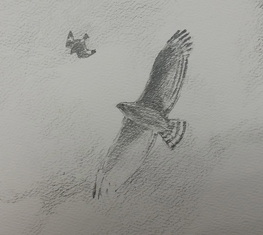 The title makes it sound as though this will be about a sunny early summer day at the beach as blisters slowly start to form on exposed shoulders. But it's not. It's more about first notes of Spring. For some people, the first notes of spring are actual notes, the jubilant bubbling calls of songbirds that warble from beaks and bills in the trees around the house. For others, it is the first brave little frog, poking a nose through the surface of vernal pools to begin repeated little peeps in hopes of finding a mate. For others, it might be the roar of air coming though an open car window when it finally becomes warm enough to drive with windows open again. For some, certain smells call up the memory of Spring. Farmers might recall the fresh smell of newly thawed dirt, almost ready to turn. Some people think of Spring when they smell cold rain on sunny pavement. Still others think of sweet-smelling hyacinth blooms, the heady fragrance drifting across the early garden. I can think of nothing that reminds me more that Spring has broken Winter's hold than a two-noted scream, floating from the sky. Living here along the Choptank River, The dominant hawk is the Red-Shouldered Hawk, a medium sized Buteo with chestnut-red shoulders and a striped tail. In the spring, the male Red-Shouldered Hawks court the females with an amazing series of diving, looping flights and loud, repeated screams. It seems that as I first begin pulling small greening winter weeds from the garden beds, I almost always hear the Red Shoulders dancing in the clouds above. They have cries that carry. Sometimes, I can pinpoint the place in the sky where their calls are coming from, but locating the birds visually is tough. Eventually, with a hand shielding the early spring sun and plenty of squinting, I can make out tiny dots looping high overhead. Despite the distance, their calls are loud and clear, as though they are soaring close overhead. Red-Shouldered Hawks have amazing courtship displays that take place in the sky over a period that spans several weeks. During these displays, the pair of hawks alternately circle each other while they repeat their two-note call. Then they take turns diving towards each other, looping as they zoom past.  When I was younger and living in Wisconsin and Ohio, I thought of the Red-Shouldered Hawk as a rare bird. Where I lived, the bigger Red-Tailed Hawks were our most often-seen hawks. Sitting on telephone poles, fence posts or on the craggy branches of dead trees, they looked so majestic looking across the landscape. Red-Shouldered Hawks were a declining and threatened species. (as were many species of Buteos) This was due, in part, to pesticides and poisons that were used routinely by farmers and homeowners. With the banning of specific pesticides, most notably DDT, the numbers of these birds have been making a steady comeback. Frogs, small snakes, mice, voles and insects make up much of the Red-Shoulder's diet. More of a woodland species that the Red-Tailed, these raptors wait patiently on a low-hanging branch, their heads tilted to catch any movement below on the forest floor or along the river's edge. Then quietly, they drop on their prey before carrying it back to the tree. Their early-spring calls and sky dances lead to nesting. Red-Shouldered Hawks typically nest for life, and while some migrate, they typically return to the same nesting area every year. Their compact but bulky nests, made of branches, usually hold three or four eggs. The female spends more time on the nest than the males, although male Red-Shoulders are good providers, carrying food to the nesting female and young. With the wooded river edge and large closely-set woodlots along the Choptank corridor, This bird can almost always be seen circling high overhead or perched on a heavy tree branch. But most of all, they call to Spring, beckoning it's return with their two-toned love song to the season. |
What's News?Kurt Plinke: About Life, Art and the Nature of Things on the Eastern ShoreI write about things I've noticed, places I've been, plans I've made and paintings I've finished or am thinking about. Archives
February 2020
See recent naturalist observations I have posted on iNaturalist:
|
|
Sewell Mills Studio & Gallery
14210 Draper's Mill Road Greensboro, MD 21639 (410) 200-1743 [email protected] |
Rights to all images on this website, created by Kurt Plinke, remain the property of Kurt Plinke. Copying or use of these images is permissible only following written permission from Kurt Plinke. To use images for any purpose, contact [email protected] for permission.


